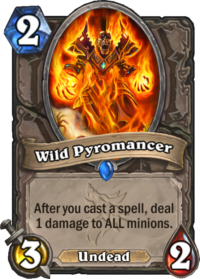If you’ve ever wondered how the triggering works for Wild Pyromancer, Max McCall discussed it on the official Hearthstone forums.

Wild Pyromancer is extremely enthusiastic about playing with fire. Even if you don’t control a Wild Pyromancer when you start casting a spell, if you control one after the spell resolves, the world is going to burn. This causes some confusion, because most triggered abilities in Hearthstone occur ‘whenever’ something happens. Why do we sometimes use ‘after’ instead?
Triggered abilities in Hearthstone work like questions. ‘Whenever’ is asking ‘Hey, you are doing something. Is it the thing I care about?’ ‘After’ asks a different question. ‘Hey, you did something. Was it the thing I care about?’ ‘Whenever’ is usually the most straightforward way of implementing triggered abilities. The trigger sees you do the thing it cares about and executes its ability. Then, you proceed with whatever triggered the ability. Typically this is to your advantage: when you use Power of the Wild to give your minions +1/+1 and have Violet Teacher in play, the Violet Teacher sees you cast the spell and creates an Apprentice before the spell resolves, so you get a 2/2 Apprentice. Sweet.
However, the timing of when exactly the trigger occurs is not always obvious. Consider a trigger that says ‘whenever this minion attacks, it gains +2 Attack.’ It’s not obvious if the attack buff is gained before or after the attack resolves; a good-faith reading could be interpreted either way, particularly for people who don’t have a fine grasp on the rules. Combat is key to Hearthstone, so you shouldn’t need a fine grasp on the rules to not be surprised by it.*
This is why we have ‘after’ in our toolbox. If we made that card, it would say ‘After this minion attacks, it gains +2 Attack.’ With ‘after’ it is unambiguous that the trigger occurs after the attack, and you can plan accordingly. We prefer ‘whenever’ but use ‘after’ in cases where we need to be more clear.
There are also some cases where we have to have the trigger occur ‘after’ for targeting reasons. Wild Pyromancer uses ‘after’ because if it used ‘whenever’ its ability would trigger before the spell you cast resolved. If you were casting Frostbolt on a minion with 1 Health, the Pyromancer’s trigger would kill the minion and it wouldn’t be in play when Frostbolt resolved. We’d have to do something inelegant to solve the problem of what should happen to Frostbolt’s visual effect in that case, so we use ‘after’ instead. Triggers that care about minions being summoned also tend to use ‘after’ because if we used ‘whenever’ the minion wouldn’t be in play when the trigger resolved, which looks weird visually and would also mean that the trigger couldn’t affect the minion being summoned. For example, Addled Grizzly wouldn’t work if it said ‘whenever.’
We’ve considered changing the rule for minions with ‘after’ triggers to only occur if the minion is in play at the start of whatever triggered them, but we decided not to. The current template for ‘after’ is clear in almost all cases, and while surprise Wild Pyromancer triggers off of e.g. Mindgames are startling, they do match the Pyromancer’s text. Since the rule is consistent and the text of ‘after’ minions match their functionality, we didn’t want to change the rules to fix this particular corner case, especially since it would introduce ambiguity with the general case for ‘after’ text.
*By rule, the trigger occurs after the attack is declared but before damage. We use ‘whenever’ on triggers like Cutpurse because the trigger isn’t relevant to combat, though.
[Source]
